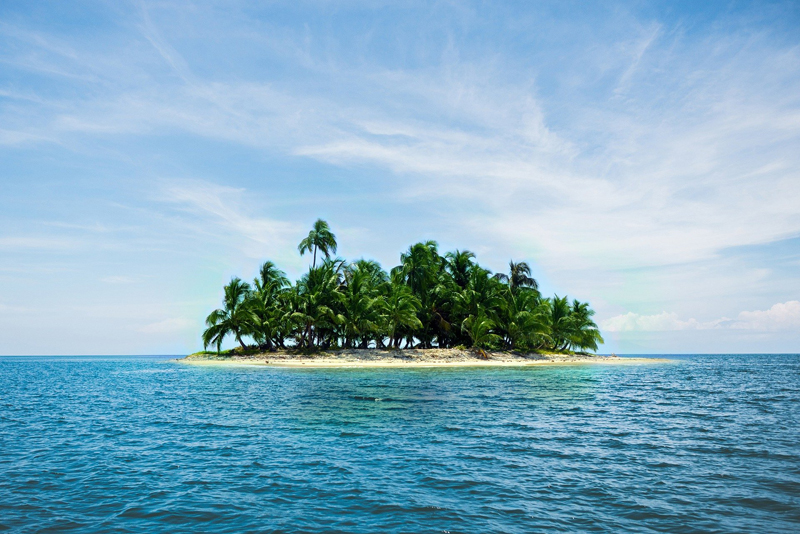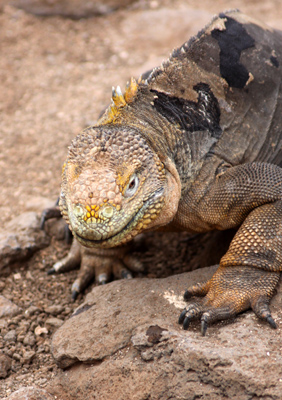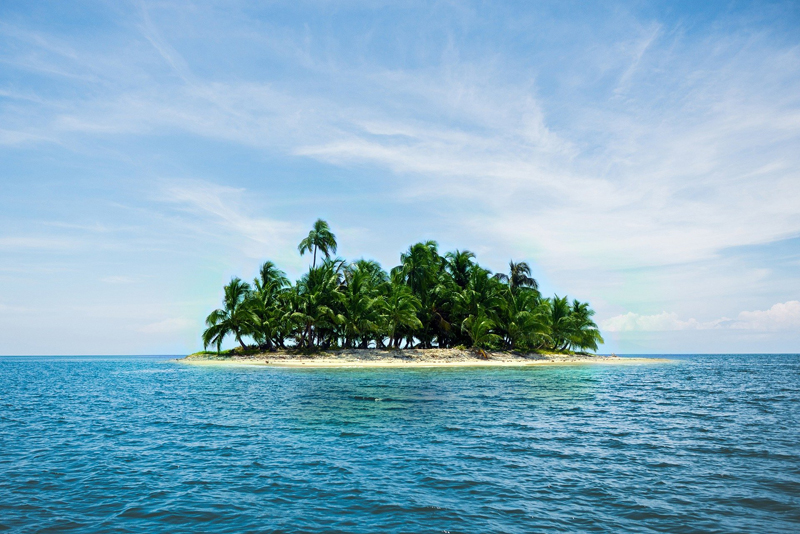Galapagos - Amazing Wildlife and Geology

An exploration of the Galapagos Islands is an adventure in variety. Most people have heard that there are some very unique species of animal found here, many of which are endemic (meaning found only here and nowhere else in the world). But what you may not realize is that the species vary from island to island within the Galapagos themselves, and even within different regions of each island. So if you see a giant tortoise or a land iguana on one island it will be slightly different from the giant tortoise or land iguana you see on another island. Even the native bird species vary from island to island.
 Part of this has to do with the fact that each of the 18 islands that make up the archipelago is very different in its climate and character. Some are extremely volcanic in nature with very little vegetation, while others are more lush; some have very rocky coasts while others have sand beaches; and even the beaches vary greatly in color and type of sand from black to red to white. So if you go to the Galapagos you need to visit multiple islands to truly get a feel for the variety of life that inspired Charles Darwin’s "The Origin of Species".
Part of this has to do with the fact that each of the 18 islands that make up the archipelago is very different in its climate and character. Some are extremely volcanic in nature with very little vegetation, while others are more lush; some have very rocky coasts while others have sand beaches; and even the beaches vary greatly in color and type of sand from black to red to white. So if you go to the Galapagos you need to visit multiple islands to truly get a feel for the variety of life that inspired Charles Darwin’s "The Origin of Species".
The good news is that pretty much the only way to see the Galapagos is via a cruise ship, and almost all stop at multiple islands. Remember that you are not allowed to set foot on any island unless you are accompanied by a naturalist working with the Galapagos National Park Service. Almost 98% of the 3,000+ sq. miles of land in the Galapagos is part of the national park and 27,000 sq. miles of ocean surrounding the islands is part of a marine reserve. The naturalists ensure you understand how to enjoy your visit to the islands and learn the most from it while protecting the natural environment at the same time.
Although the Galapagos Islands straddle the equator, they are not as hot as many may think. The Humboldt Current, coming up the coast of South America, and the Cromwell Current, or Equatorial Counter-Current, help to cool the islands and keep the daytime temperatures in the 70’s pretty much year round. Seasonal differences arise in the amount of wind, fog and rain, but more importantly in water temperatures. The "dry" season runs from May to November, but this is also the time of year with chillier air temperatures, more wind, and much chillier water temperatures. So the best time to visit is, ironically, in the "wet" season from December to May. Don't worry - even though it's the wet season, the Galapagos Islands have far less rain than most tropical islands and it equates to the same as the dry season in other places. But don’t select this as your vacation if you are looking to loll on a tropical beach; even in the warmer wet season, visiting the Galapagos is much more about exploring the environment, encountering numerous unique species in the wild, and learning. And those of us who love taking photographs of animals go literally crazy with the unique variety of wildlife on these islands, most of which have little to no fear of humans.
So how do each of these islands differ from each other?
North Seymour is the closest to the airport island of Baltra and therefore often the first island visited. The loop hiking trail on North Seymour is a bit challenging, climbing over and around lava boulders, but it offers you the opportunity of visiting nesting grounds for frigate birds (both great and magnificent varieties), swallow-tailed gulls, and, of course, the famously named blue-footed boobies. And the shoreline is literally strewn with sea lions and their absolutely adorable pups. Due to weather conditions in the Galapagos, there is no one “mating season” for sea lions so you can see pups pretty much year round.
The island of Bartolome offers a striking difference in a rather barren almost moonlike volcanic environment. To protect the fragile tuff landscape the National Park service built a wooden staircase (376 steps, apparently) that leads through the wind-crafted features in the volcanic ash, spatter cones and tuff cones up to a peak of 359 feet above sea level for a striking view. You will see few animals since not many plants can withstand the drought conditions due to Bartolome being in the rain shadow of the much larger Santa Cruz Island to the southeast.
 Santa Cruz has the largest human population of all of the islands, centered in the town of Puerto Ayora, with an estimated 18,000 people. It is also home to the Charles Darwin Research Station which is operating numerous programs to help repopulate endangered species of giant tortoise and land iguanas from various islands. But most importantly, in my opinion, it is the island with the highest population of wild giant tortoises, which migrate from the lowlands that are essentially grassy plains during the rainy season up to the more humid, and therefore more lush, meadow areas of the highlands during the dry season. Yes, these ploddingly slow creatures do actually migrate! If you take a wander through the meadow areas of the giant tortoise preserve you can’t help but stumble upon a fair number of these “walking boulders”.
Santa Cruz has the largest human population of all of the islands, centered in the town of Puerto Ayora, with an estimated 18,000 people. It is also home to the Charles Darwin Research Station which is operating numerous programs to help repopulate endangered species of giant tortoise and land iguanas from various islands. But most importantly, in my opinion, it is the island with the highest population of wild giant tortoises, which migrate from the lowlands that are essentially grassy plains during the rainy season up to the more humid, and therefore more lush, meadow areas of the highlands during the dry season. Yes, these ploddingly slow creatures do actually migrate! If you take a wander through the meadow areas of the giant tortoise preserve you can’t help but stumble upon a fair number of these “walking boulders”.
Isabela is the largest of the Galapagos Islands and therefore offers the greatest variety in terrain. One of its most interesting aspects is a section that was an underwater reef only about 50 years ago and was then very suddenly uplifted by underground pressure, raised about 13 feet above sea level in a very short period of time, leaving many marine creatures stranded. The area, besides having remnants of its marine past, is now home to some very large colorful land iguanas. Another portion of Isabela offers hiking across broken lava flows to find oases of brackish water lagoons that host numerous shorebirds.
Champion Island is a tiny islet off of Floreana Island, and is one of the few remaining places where the Charles mockingbird still exists, having become extinct on the larger islands. The rocky cliffs around the islet also provide nesting grounds for the red-billed tropicbird which is so graceful in flight with the long tail feathers trailing. Floreana Island itself has wide variety – a greenish lava beach popular with sea lions, a fine white sand beach that is a favorite nesting site for Pacific black sea turtles, and in between a brackish pond with some of the rare coral-colored flamingos.
And that gives you a sense of only five of the 18 islands of the Galapagos. The variety of landscape is surprising and the variety of wildlife is astounding.
If you're ready to plan a trip to the Galapagos, I can’t recommend highly enough traveling with a reliable, professional organization that will help you really get the most out of your time in these islands. My personal favorite is the organization we traveled with – the partnership of Lindblad Expeditions and National Geographic, on the Islander. The shipboard service is impeccable, the naturalists are extremely professional and interesting, and the entire crew goes out of their way to ensure your expedition is an excellent experience.
However you get there, the important thing is to go!
Note: no promotional consideration was provided or paid for this article.
 Part of this has to do with the fact that each of the 18 islands that make up the archipelago is very different in its climate and character. Some are extremely volcanic in nature with very little vegetation, while others are more lush; some have very rocky coasts while others have sand beaches; and even the beaches vary greatly in color and type of sand from black to red to white. So if you go to the Galapagos you need to visit multiple islands to truly get a feel for the variety of life that inspired Charles Darwin’s "The Origin of Species".
Part of this has to do with the fact that each of the 18 islands that make up the archipelago is very different in its climate and character. Some are extremely volcanic in nature with very little vegetation, while others are more lush; some have very rocky coasts while others have sand beaches; and even the beaches vary greatly in color and type of sand from black to red to white. So if you go to the Galapagos you need to visit multiple islands to truly get a feel for the variety of life that inspired Charles Darwin’s "The Origin of Species".The good news is that pretty much the only way to see the Galapagos is via a cruise ship, and almost all stop at multiple islands. Remember that you are not allowed to set foot on any island unless you are accompanied by a naturalist working with the Galapagos National Park Service. Almost 98% of the 3,000+ sq. miles of land in the Galapagos is part of the national park and 27,000 sq. miles of ocean surrounding the islands is part of a marine reserve. The naturalists ensure you understand how to enjoy your visit to the islands and learn the most from it while protecting the natural environment at the same time.
Although the Galapagos Islands straddle the equator, they are not as hot as many may think. The Humboldt Current, coming up the coast of South America, and the Cromwell Current, or Equatorial Counter-Current, help to cool the islands and keep the daytime temperatures in the 70’s pretty much year round. Seasonal differences arise in the amount of wind, fog and rain, but more importantly in water temperatures. The "dry" season runs from May to November, but this is also the time of year with chillier air temperatures, more wind, and much chillier water temperatures. So the best time to visit is, ironically, in the "wet" season from December to May. Don't worry - even though it's the wet season, the Galapagos Islands have far less rain than most tropical islands and it equates to the same as the dry season in other places. But don’t select this as your vacation if you are looking to loll on a tropical beach; even in the warmer wet season, visiting the Galapagos is much more about exploring the environment, encountering numerous unique species in the wild, and learning. And those of us who love taking photographs of animals go literally crazy with the unique variety of wildlife on these islands, most of which have little to no fear of humans.
So how do each of these islands differ from each other?
North Seymour is the closest to the airport island of Baltra and therefore often the first island visited. The loop hiking trail on North Seymour is a bit challenging, climbing over and around lava boulders, but it offers you the opportunity of visiting nesting grounds for frigate birds (both great and magnificent varieties), swallow-tailed gulls, and, of course, the famously named blue-footed boobies. And the shoreline is literally strewn with sea lions and their absolutely adorable pups. Due to weather conditions in the Galapagos, there is no one “mating season” for sea lions so you can see pups pretty much year round.
The island of Bartolome offers a striking difference in a rather barren almost moonlike volcanic environment. To protect the fragile tuff landscape the National Park service built a wooden staircase (376 steps, apparently) that leads through the wind-crafted features in the volcanic ash, spatter cones and tuff cones up to a peak of 359 feet above sea level for a striking view. You will see few animals since not many plants can withstand the drought conditions due to Bartolome being in the rain shadow of the much larger Santa Cruz Island to the southeast.
 Santa Cruz has the largest human population of all of the islands, centered in the town of Puerto Ayora, with an estimated 18,000 people. It is also home to the Charles Darwin Research Station which is operating numerous programs to help repopulate endangered species of giant tortoise and land iguanas from various islands. But most importantly, in my opinion, it is the island with the highest population of wild giant tortoises, which migrate from the lowlands that are essentially grassy plains during the rainy season up to the more humid, and therefore more lush, meadow areas of the highlands during the dry season. Yes, these ploddingly slow creatures do actually migrate! If you take a wander through the meadow areas of the giant tortoise preserve you can’t help but stumble upon a fair number of these “walking boulders”.
Santa Cruz has the largest human population of all of the islands, centered in the town of Puerto Ayora, with an estimated 18,000 people. It is also home to the Charles Darwin Research Station which is operating numerous programs to help repopulate endangered species of giant tortoise and land iguanas from various islands. But most importantly, in my opinion, it is the island with the highest population of wild giant tortoises, which migrate from the lowlands that are essentially grassy plains during the rainy season up to the more humid, and therefore more lush, meadow areas of the highlands during the dry season. Yes, these ploddingly slow creatures do actually migrate! If you take a wander through the meadow areas of the giant tortoise preserve you can’t help but stumble upon a fair number of these “walking boulders”.Isabela is the largest of the Galapagos Islands and therefore offers the greatest variety in terrain. One of its most interesting aspects is a section that was an underwater reef only about 50 years ago and was then very suddenly uplifted by underground pressure, raised about 13 feet above sea level in a very short period of time, leaving many marine creatures stranded. The area, besides having remnants of its marine past, is now home to some very large colorful land iguanas. Another portion of Isabela offers hiking across broken lava flows to find oases of brackish water lagoons that host numerous shorebirds.
Champion Island is a tiny islet off of Floreana Island, and is one of the few remaining places where the Charles mockingbird still exists, having become extinct on the larger islands. The rocky cliffs around the islet also provide nesting grounds for the red-billed tropicbird which is so graceful in flight with the long tail feathers trailing. Floreana Island itself has wide variety – a greenish lava beach popular with sea lions, a fine white sand beach that is a favorite nesting site for Pacific black sea turtles, and in between a brackish pond with some of the rare coral-colored flamingos.
And that gives you a sense of only five of the 18 islands of the Galapagos. The variety of landscape is surprising and the variety of wildlife is astounding.
If you're ready to plan a trip to the Galapagos, I can’t recommend highly enough traveling with a reliable, professional organization that will help you really get the most out of your time in these islands. My personal favorite is the organization we traveled with – the partnership of Lindblad Expeditions and National Geographic, on the Islander. The shipboard service is impeccable, the naturalists are extremely professional and interesting, and the entire crew goes out of their way to ensure your expedition is an excellent experience.
However you get there, the important thing is to go!
For more info on the Galapagos Islands and the underwater adventures you can enjoy there, please read this article: Galapagos – Underwater Surprises
Note: no promotional consideration was provided or paid for this article.
You Should Also Read:
Galapagos - Underwater Surprises

Related Articles
Editor's Picks Articles
Top Ten Articles
Previous Features
Site Map
Content copyright © 2023 by Laura Hartney. All rights reserved.
This content was written by Laura Hartney. If you wish to use this content in any manner, you need written permission. Contact Malika Bowling for details.



